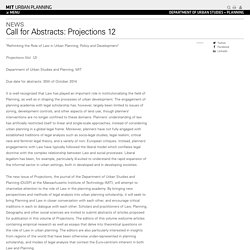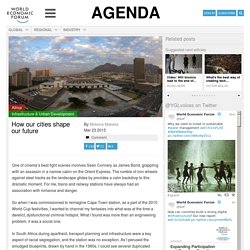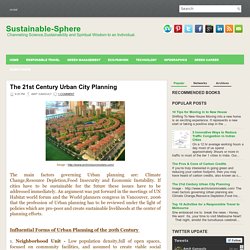

Privatepublicspace.pdf. Call for Abstracts: Projections 12. "Rethinking the Role of Law in Urban Planning, Policy and Development" Projections (Vol. 12) Department of Urban Studies and Planning, MIT Due date for abstracts: 30th of October 2014 It is well recognized that Law has played an important role in institutionalizing the field of Planning, as well as in shaping the processes of urban development.

The engagement of planning academia with legal scholarship has, however, largely been limited to issues of zoning, development controls, and other aspects of land use, though planners’ interventions are no longer confined to these domains. The new issue of Projections, the journal of the Department of Urban Studies and Planning (DUSP) at the Massachusetts Institute of Technology (MIT), will attempt to channelize attention to the role of Law in the planning academy.
The scope of this volume includes, but is not limited to, heterodox legal analysis on topics related to processes of urbanization such as: Spatial_planning.e.pdf. Effective law and regulation for disaster risk reduction. What is the most private city in the world? LNC-9s03-2014p. How our cities shape our future. One of cinema’s best fight scenes involves Sean Connery as James Bond, grappling with an assassin in a narrow cabin on the Orient Express.

The rumble of iron wheels against steel tracks as the landscape glides by provides a calm backdrop to this dramatic moment. For me, trains and railway stations have always had an association with romance and danger. So when I was commissioned to reimagine Cape Town station, as a part of the 2010 World Cup festivities, I wanted to channel my fantasies into what was at the time a derelict, dysfunctional criminal hotspot. What I found was more than an engineering problem, it was a social one. In South Africa during apartheid, transport planning and infrastructure were a key aspect of racial segregation, and the station was no exception. A poisoned ecology The dysfunctional nature of the station’s architecture and public spaces was compounded by the lack of any proper refurbishment. Apartheid-era urban planning nurtured poverty and inequality.
Planning_Act_2007.pdf. Summary national policy strategy for infrastructure and spatial planning. Spatialplanning. The 21st Century Urban City Planning ~ Sustainable-Sphere. The main factors governing Urban planning are: Climate Change,Resource Depletion,Food Insecurity and Economic Instability.

If cities have to be sustainable for the future these issues have to be addressed immediately. An argument was put forward in the meetings of UN Habitat world forum and the World planners congress in Vancouver, 2006 that the profession of Urban planning has to be reviewed under the light of policies which are pro-poor and create sustainable livelihoods at the center of planning efforts. Influential Forms of Urban Planning of the 20th Century 1. Neighborhood Unit - Low population density,full of open spaces, focused on community facilities, and assumed to create viable social communities. 2.Radburn Layout - Separates motorized traffic from pedestrians, characterized by open spaces and super blocks free of traffic. 3. 4. 5. The challenges confronting the cities of 21st Century Environmental Concern - 2. Economic Concern - 1. 2. Urban Population Expansion - 1. New Theoretical Perspectives on the Distribution of Income and Wealth Among Individuals.
Alta densidad: vivir en un edificio. 16 marzo, 2015 por Pedro Hernández Martínez | @laperiferia Este fin de semana salía publicado en el blog Verne de El País un divertido texto donde se investigaba cuanta superficie necesitaría toda la población del mundo –unos 7,300 millones de personas- para caber todas juntas, una junto a otra, hombro con hombro.

El resultado es cuanto menos sorprendente: toda la población mundial puesta de pie cabría en un cuadrado de 5,7km x 5,7 km. Trasponiendo eso a un volumen, el autor del artículo, Tim Urban, nos comenta que sólo necesitaríamos un cubo de 1,07 kilómetros de lado –algo más alto que el Burj Kalifa en Dubai- de lado para albergar incómodamente a cada persona del mundo. El edificio imaginado por Urban no examina elementos como puertas, habitaciones, suelos, techos o usos y programas arquitectónicos destinados al tiempo libre, al trabajo, al juego, al consumo o cualquier otro que nos imaginemos. Más bien la propuesta sólo se dedica a acumular a toda persona viva existente en el mundo.